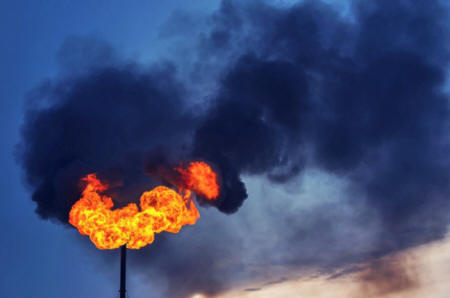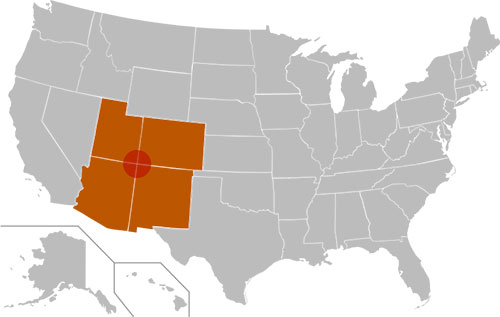|

by
Mike G.
October 17, 2014
from
DesmogBlog Website

Black smoke from burning of
associated gas
Image Credit: Leonid Ikan
When NASA researchers first
saw data indicating a massive cloud of methane floating over the
American Southwest, they found it so incredible that they
dismissed it as an instrument error.
But as they continued analyzing data from the European Space
Agency’s Scanning Imaging Absorption Spectrometer for Atmospheric
Chartography (SCIAMACHY)
instrument from 2002 to 2012, the "atmospheric hot spot" kept
appearing.
The team at NASA was finally able to take
a closer look, and have now concluded that
there is in fact a 2,500-square-mile cloud of methane - roughly
the size of Delaware - floating over the Four Corners region
(below image), where the borders of Arizona, Colorado, New Mexico,
and Utah all intersect.

A report published by the NASA researchers
in the journal Geophysical Research Letters (Four
Corners - The Largest U.S. Methane Anomaly Viewed from Space)
concludes that,
"the source is
likely from established gas, coal, and coal-bed methane mining
and processing."
Indeed, the hot spot happens to be above New Mexico's
San Juan Basin, the
most productive coalbed methane basin in North
America.
Methane is 20-times more potent as a greenhouse gas
than CO2, and has been
the focus of an increasing amount of attention, especially in
regards to
methane leaks from fracking for oil
and natural gas.
Pockets of natural gas, which is 95-98% methane, are
often found along with oil and simply burned off in a very visible
process called "flaring."
But scientists are starting to realize that far more
methane is being released by
the fracking boom than previously
thought.
Earlier this year, Cornell environmental engineering professor
Anthony Ingraffea released the results of a study of 41,000 oil
and gas wells (Assessment
and Risk Analysis of Casing and Cement Impairment in Oil and Gas
Wells in Pennsylvania)
that were drilled in Pennsylvania between 2000 and 2012, and
found newer wells using fracking and horizontal drilling methods
were far more likely to be responsible for fugitive emissions of
methane.
According to the NASA researchers, the
region of the American Southwest over which the 2,500-square-foot
methane cloud is floating emitted 590,000 metric tons of methane
every year between 2002 and 2012 - almost 3.5 times the widely used
estimates in the European Union’s
Emissions Database for Global Atmospheric
Research - and none of it was from fracking.
That should prompt a hard look at the entire fossil fuel sector, not
just fracking, according to University of Michigan Professor Eric
Kort, the lead researcher on the study:
"While fracking has become a focal point in
conversations about methane emissions, it certainly appears from
this and other studies that in the U.S.,
fossil fuel extraction activities across the board likely emit
higher than inventory estimates."
|


